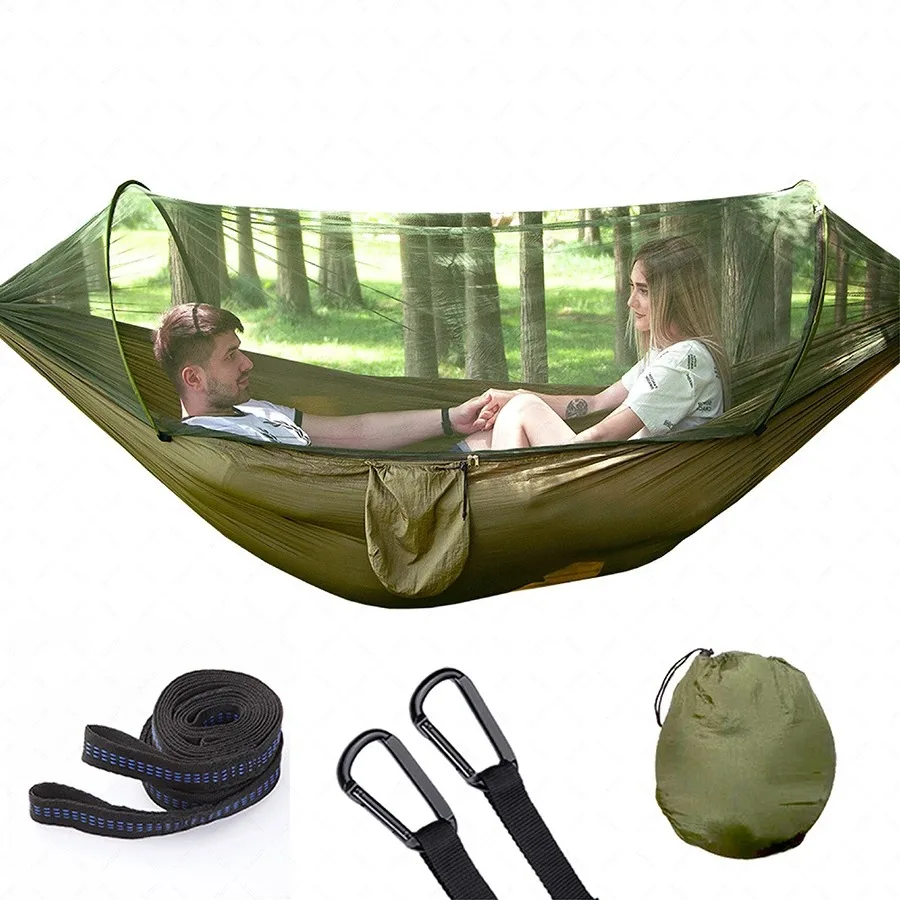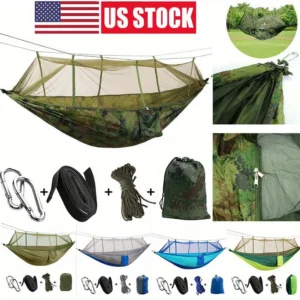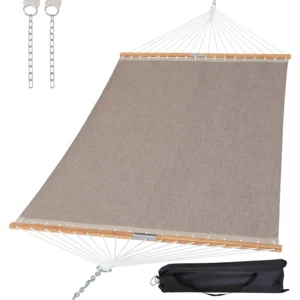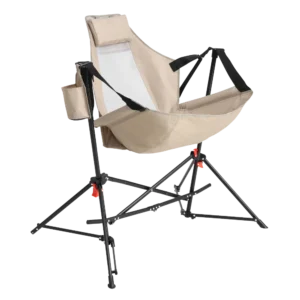Introduction: Why Smart Hammock Packing Matters for Hikers
Hiking with a hammock opens up amazing sleep options on the trail, but there’s a challenge many hikers face: how to efficiently pack this awkward piece of gear. Proper hammock packing isn’t just about saving space—it’s about protecting your investment and maintaining trail efficiency when every ounce and cubic inch matters.
There’s a significant difference between casually folding a hammock at home and strategically packing it for a backcountry adventure. The difference can mean:
- Saving up to 30% of valuable pack space
- Preventing damage to hammock fabrics and components
- Ensuring quick setup when you arrive at camp tired
- Maintaining balance and comfort while hiking
One of the first decisions you’ll face is whether to stuff or fold your hammock. This ongoing debate among hikers has practical implications for your trail experience and gear longevity. Throughout this guide, we’ll explore both methods, with special attention to the ultralight hammock packing techniques that can transform your hiking experience.
By the end of this article, you’ll have a complete system for efficiently packing your hammock that aligns with your specific hiking style and equipment.
The Stuffing Method: Why Most Hikers Prefer This Technique
Stuffing a hammock—randomly compressing it into its storage sack rather than folding it—has become the preferred method for experienced hikers, and for good reasons grounded in both materials science and practical trail experience.
When you stuff a hammock, you’re creating random compression patterns throughout the fabric. This randomization serves an important purpose: it prevents stress from repeatedly forming along the same fold lines. Over time, consistent folding creates memory in fabric fibers, potentially weakening them at predictable points.
Key benefits of the stuffing method include:
- Prevention of fabric stress points – Random stuffing distributes wear across the entire hammock rather than concentrating it along fold lines
- Adaptable packing shape – A stuffed hammock conforms better to odd spaces in your backpack, filling gaps between other gear
- Speed in field conditions – When you’re breaking camp in rain, cold, or challenging terrain, stuffing is significantly faster
- Versatility across materials – Works equally well for silnylon, ripstop, and other common hammock fabrics
- Minimal skill required – Less precision needed compared to perfect folding techniques
Many ultralight camping hammock sets now ship with instructions specifically recommending stuffing over folding. This isn’t just manufacturer preference—it reflects the real-world experience of countless hikers who have found stuffing to be the superior method for trail use.
For hiking purposes, the informal nature of stuffing actually becomes its greatest strength. The slight randomness in how the fabric compresses each time helps extend the life of your hammock while making the packing process more forgiving in field conditions.
Step-by-Step Guide to Stuffing Your Hammock
Follow these steps to properly stuff your hammock for hiking:
Prepare your hammock
* Shake out any debris, leaves, or moisture
* Untangle any attached suspension systems
* If the hammock is wet, give it a quick shake to remove excess waterGet your stuff sack ready
* Turn it inside out if it’s damp to keep the interior dry
* Open it wide and place it on a clean surface
* Hold the opening open with one handBegin the stuffing process
* Gather the hammock loosely in your hands, working from one end
* Start pushing the center of the hammock into the stuff sack first
* Use short, controlled pushes rather than forcing large amounts at onceContinue stuffing with alternating sides
* After the middle is in, alternate pushing in material from either end
* This creates more random compression patterns
* Don’t worry about neatness—randomness is actually beneficialHandle integrated features carefully
* For bug nets: stuff them alongside the hammock body, not separately
* For ridge lines: allow them to go in naturally with the fabric
* For attachments: tuck these in last to prevent tanglingApply compression techniques
* Once fully stuffed, close the stuff sack
* For standard stuff sacks, pull the drawstring tight
* For hammock compression techniques with compression straps, gradually tighten each strap in sequence
Common mistakes to avoid include twisting the hammock while stuffing (creates unnecessary bulk), compressing before fully stuffed (creates uneven density), and forcing too much material at once (can damage the stuff sack seams).
For experienced hikers looking to save time, try the “quick-stuff” method: hold the stuff sack with both hands and simply push the entire gathered hammock in at once, adjusting as needed. With practice, you can stuff most hammocks in under 30 seconds.
The Folding Method: When It Makes Sense for Hikers
While stuffing is generally preferred, there are specific scenarios where folding provides advantages for hikers:
- Hammocks with rigid components – Some specialized hammocks include stiffened sections or integrated spreader bars that benefit from methodical folding
- Hybrid hammock-tent systems – Products that combine hammock and ground functionality often fold better along designed lines
- Frame-integrated hammocks – Hammocks with structural elements need folding that accommodates these components
- Personal organization preference – Some hikers simply prefer the visual organization of a folded system
The key difference between everyday folding and trail-optimized folding is intentionality. When folding for hiking, the focus remains on creating a compact package that protects the hammock while consuming minimal space. This differs significantly from decorative home folding, which prioritizes appearance.
Despite these specific scenarios, folding does come with notable drawbacks in most hiking contexts:
- Creates consistent stress points along fold lines
- Typically results in a less flexible packed shape
- Takes longer in adverse weather conditions
- Requires a flat, clean surface that’s often unavailable on trail
For hikers committed to an ultimate guide ultralight hammock setup, folding generally adds unnecessary time and potential stress points. However, if your hammock design specifically benefits from folding or you strongly prefer this method, the next section provides the most efficient approach.
Step-by-Step Guide to Folding Your Hammock
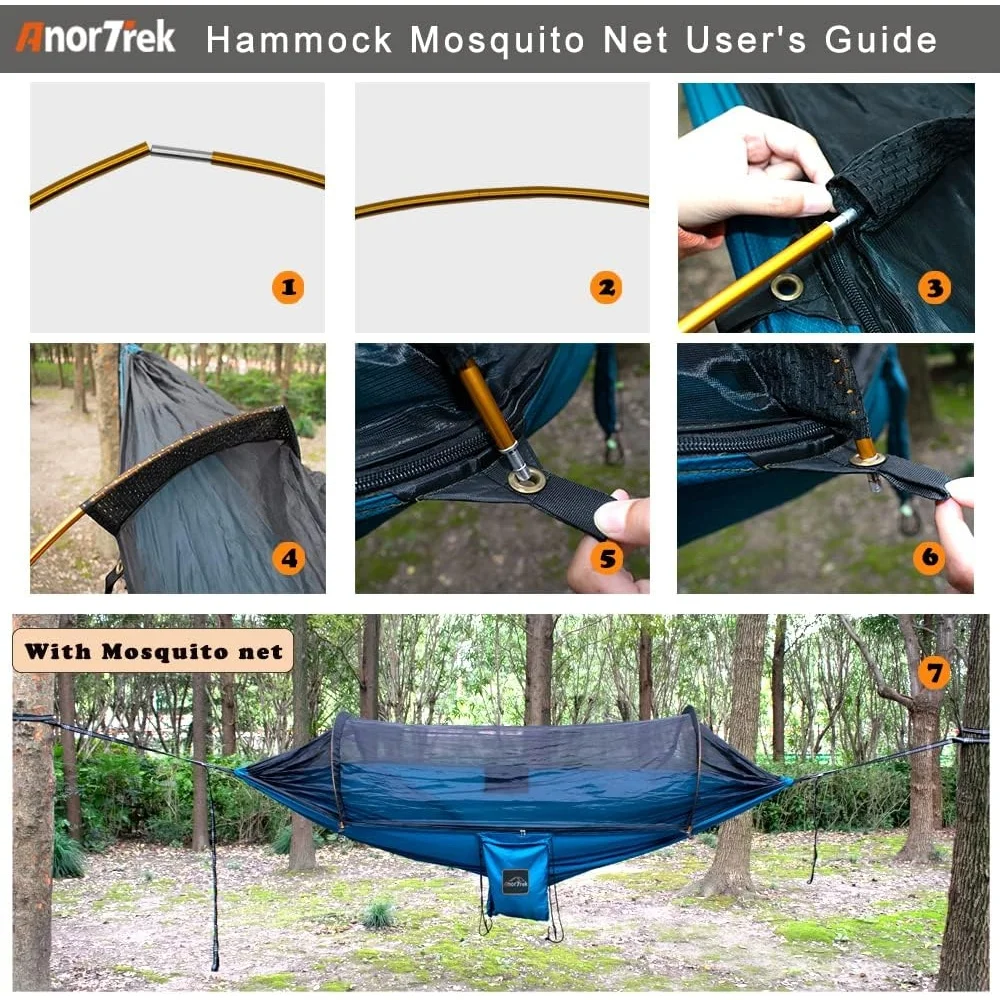
If folding is necessary for your hammock type or personal preference, follow this trail-optimized folding process:
Select and prepare your surface
* Find the cleanest, flattest area available
* A tent footprint or groundsheet makes an ideal folding surface
* In wet conditions, use the inside of your rain jacket as a clean surfaceStraighten and align the hammock
* Lay the hammock out completely flat
* Align any seams or centerlines
* Smooth out major wrinkles without obsessing over perfectionPerform width folding
* Fold the hammock in thirds or halves width-wise
* Keep edges aligned but don’t stress over perfect symmetry
* For hammocks with bug nets, fold the net in first, then the bodyExecute length folding
* Fold the hammock in half lengthwise
* Then fold in half or thirds again, depending on your stuff sack size
* Maintain loose rather than sharp creasesChoose your final compression method
* Option A: Roll the folded hammock from one end
* Option B: Keep it flat-folded for hammocks with rigid elements
* Adjust based on your specific stuff sack shape
When folding hammocks with integrated components:
* Allow bug nets to fold naturally with the hammock body
* Place suspension systems in the center of folds to prevent edge stress
* Alternate fold directions for metal or plastic components to distribute bulk
Practicing mastering pack efficiently pack hammock techniques at home before your trip can significantly improve your trail experience. The ideal fold should create a package that’s only slightly larger than the stuffing method while still protecting specialized components.
Essential Gear for Optimal Hammock Packing
The right storage accessories can dramatically improve your hammock packing experience:
Storage Sack Options:
- Standard Stuff Sacks: The most common option, typically included with hammocks. Usually cylindrical with a simple drawstring closure.
- Compression Sacks: Feature additional straps that cinch down after stuffing, reducing volume by 15-30%. Worth the slight weight increase (0.5-2 oz/14-56 g) for longer trips.
- Double-Ended Stuff Sacks: Allow access from both ends, making stuffing faster and more convenient.
Material Considerations:
- Sil-nylon: Lightweight, somewhat water-resistant, fast-drying
- Waterproof Fabrics: Heavier but provide better protection in consistently wet environments
- Breathable Fabrics: Best for long-term storage but typically less compact
Specialized Hammock Accessories:
- Snake Skins/Sleeves: Tube-shaped covers that slide over suspended hammocks, allowing you to pack while keeping suspension attached to trees
- Integrated Stuff Pouches: Some hammocks feature attached stuff sacks that can’t be lost
- Suspension Storage Options: Dedicated pouches for straps and hardware prevent tangling
When selecting storage options, consider that a quality compression sack typically adds $15-25 to your setup but can save significant pack space. For frequent hikers, dedicated camping hammocks stands and accessories are worth the investment for their durability and specialized features.
The ideal storage solution balances weight, protection, and ease of use—prioritizing based on your typical hiking conditions and personal preferences.
Backpack Integration: Where to Pack Your Hammock

Strategic hammock placement within your backpack affects both comfort while hiking and convenience at camp:
Internal Placement Options:
* Mid-pack position: Ideal for balanced weight distribution
* Bottom zone: Good for items not needed until camp
* Top section: Best for quick-access if rain threatens during your hike
External Attachment Considerations:
* Outside pocket storage: Convenient but exposes hammock to branches and moisture
* Compression strap attachment: Frees internal space but risks snagging or loss
* Top lid placement: Balanced compromise between protection and accessibility
When making your placement decision, consider:
- How often you’ll need to access your hammock during the day
- Weather conditions and exposure risks
- Your overall pack organization system
- The weight of your complete hammock system
A complete hammock setup typically weighs 1-3 pounds (0.45-1.36 kg), making it a moderate consideration in your ultimate guide packability lightweight hammocks strategy. For optimal weight distribution, most hikers benefit from keeping the hammock inside their pack unless space constraints make external attachment necessary.
If carrying the hammock externally, always use a waterproof stuff sack and position it where it won’t catch on trail obstacles or affect your balance on technical terrain.
Managing Wet Hammocks: Field Packing Solutions
Dealing with moisture is one of the biggest challenges of hammock camping. When you need to pack a wet hammock:
- Shake vigorously before packing to remove as much water as possible
- Separate wet components from dry gear using a dedicated wet storage bag
- Pack loosely rather than compressing tightly to allow some airflow
- Position away from dry gear in your backpack, ideally in an exterior pocket
- Utilize lunch breaks to briefly hang and dry your hammock in sunny conditions
For overnight storage of wet hammocks:
* Store in a breathable (not waterproof) sack to allow moisture evaporation
* Hang from a tree branch or trekking pole if weather permits during breaks
* Avoid keeping wet hammocks compressed for more than 24 hours if possible
The moisture management approach varies by fabric type. Synthetic hammocks like those found in many camping hammock sets bug net combinations are more forgiving when stored damp, while natural fibers need more careful attention to prevent mildew growth.
After your trip, always fully dry your hammock before long-term storage, regardless of how you managed it in the field.
Special Considerations for Different Hammock Types
| Hammock Type | Packing Method | Special Considerations |
|---|---|---|
| Ultralight Single Layer | Stuffing | Very compressible; protect from sharp objects |
| Double Layer | Stuffing | Takes slightly more space; layer edges may align when stuffing |
| Integrated Bug Net | Modified Stuffing | Pack bug net first, then hammock body |
| Bridge Hammock | Folding | Align spreader bars; avoid bending structural components |
| Hammock with Underquilt | Separate Packing | Pack separately unless using a specialized system |
For ultralight hammocks, proper stuffing can reduce packed size by up to 40% compared to casual rolling. Lightweight hammock sets benefit particularly from compression techniques that maintain their space-saving advantage.
When managing complex hammock systems:
* Keep hardware components centered in the packed bundle to prevent poking
* Consider removing detachable spreader bars and packing separately
* Use dedicated compartments for suspension systems to prevent tangling
* Store small components in labeled pouches for quick identification
Each hammock design presents unique packing challenges, but adapting the basic principles of either stuffing or folding to your specific equipment will yield the best results.
Quick-Deploy Packing: Setting Up for Efficiency
Strategic packing can dramatically reduce your camp setup time:
- Pack suspension systems last so they come out first
- Keep tree straps accessible in an outer pocket for immediate access
- Store small components (carabiners, toggles) in consistent, easy-to-reach locations
- Consider “reverse packing” by organizing gear in the order you’ll need it at camp
Advanced hikers using quick-setup hammock sets can achieve setup times under two minutes with proper packing techniques. The key is creating a system where each component emerges from your pack in the exact order needed for setup.
Tips for maximum efficiency:
* Practice your setup sequence at home and pack accordingly
* Keep a mental checklist of steps to prevent backtracking
* Organize components in stuff sacks by usage order, not by type
* Connect compatible components before packing when possible
The small time investment in organized packing pays significant dividends when setting up camp in challenging conditions like approaching darkness, rain, or extreme temperatures.
Long-Term Care: Home Storage Between Hikes
The way you store your hammock between adventures significantly impacts its lifespan:
- Clean thoroughly before long-term storage—remove dirt, oils, and especially food residue
- Ensure complete drying before packing away to prevent mildew and fabric deterioration
- Store loosely in a breathable cotton bag, not compressed in a stuff sack
- Keep in climate-controlled environments away from extreme heat, cold, or humidity
- Avoid direct sunlight during storage which can degrade fabrics over time
Before your next trip, implement a quick inspection routine:
1. Check all seams and stress points
2. Inspect suspension systems for wear
3. Test any integrated features like zippers or clips
4. Look for developing weak points or tears
Proper conquering clutter brilliant hammock storage between trips can extend your hammock’s life by years. The small effort of proper home storage preserves both the functionality and appearance of your investment.
FAQs: Common Hammock Packing Questions
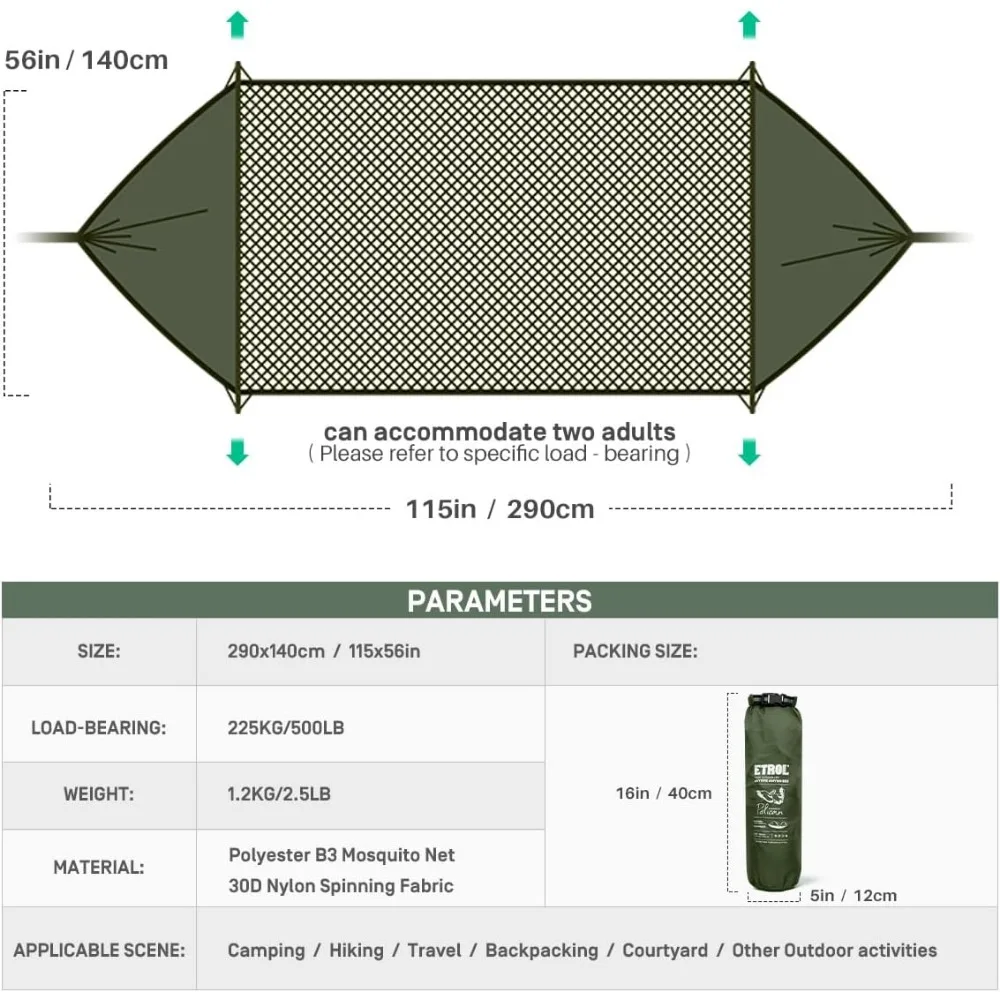
Should I separate my suspension system when packing?
For most hiking situations, packing suspension separately reduces tangles and allows for better space utilization. Store straps and hardware in a small dedicated bag near the top of your pack for quick access.
Can compression damage my hammock over time?
Short-term compression during a trip won’t harm quality hammocks. However, long-term storage under compression can weaken fibers and reduce loft in insulated hammocks. Always store loosely between trips.
How small should I expect my hammock to compress?
A basic single hammock typically compresses to about the size of a softball (3-4 inches/7.6-10.2 cm diameter). Complete systems with bug nets and integrated features usually pack to about the size of a 1-liter water bottle.
Is it better to attach my hammock outside my backpack?
Internal storage provides better protection from moisture, snags, and loss. External attachment should only be used when internal space is limited or for quick-drying wet hammocks.
What’s the fastest way to pack a hammock in rainy conditions?
Use the stuffing method while standing under your tarp. Pack the hammock directly from its hanging position using a snake skin/sleeve system if available, or quickly gather it and stuff without laying it on wet ground.
For more real-world perspectives, hikers often discuss their preferences for folding vs. stuffing methods in online communities.
Camping Hammock Sets with Bug Net, Ultralight Camping Hammock Sets
$139.72 Select options This product has multiple variants. The options may be chosen on the product pageFolding Hammock Sets, Quick Setup Hammock Sets
Price range: $305.52 through $583.27 Select options This product has multiple variants. The options may be chosen on the product pageCamping Hammock Sets with Bug Net, Complete Camping Hammock Systems
Price range: $82.73 through $97.96 Select options This product has multiple variants. The options may be chosen on the product pageFolding Hammock Sets, Lightweight Hammock Sets
$295.80 Select options This product has multiple variants. The options may be chosen on the product pageComplete Camping Hammock Systems, Hanging Egg Chair Sets
$266.73 Select options This product has multiple variants. The options may be chosen on the product page
Pro Tips: Advanced Hammock Packing Hacks
Take your hammock packing to the next level with these expert techniques:
- Multi-function stuff sack: Line your hammock stuff sack with a t-shirt or soft clothing and use it as a pillow at night
- Compression strap repurposing: Use your stuff sack compression straps as emergency repair tools or gear attachments
- Daisy chain storage: Create a simple cord daisy chain to organize and quickly deploy suspension systems
- Double-duty dry bag: Use a waterproof compression sack that can double as a food bag or clothes washer
- Snake skin storage: Leave tree straps connected to snake skins for instant deployment at your next site
- Quick-release knot systems: Learn 2-3 specialized knots that deploy and release quickly for maximum efficiency
Implementing these advanced lightweight hammock gear organization techniques can save up to 5 minutes in setup and teardown time. The combination of smart packing and refined processes transforms the hammock camping experience from merely convenient to truly enjoyable in all conditions.
Final Thoughts: Personal Perfection in Hammock Packing
While we’ve covered optimal techniques, the perfect hammock packing system is ultimately the one that works best for you. Your ideal method will evolve based on your specific gear, environmental conditions, and personal preferences.
Most hikers will find that stuffing offers the best balance of efficiency, protection, and simplicity for trail use. However, don’t be afraid to experiment and develop a personalized approach that meets your unique needs.
Remember that the goal isn’t perfect aesthetics—it’s creating a system that:
* Protects your hammock from damage
* Makes efficient use of pack space
* Enables quick setup and takedown
* Works reliably in all trail conditions
With practice, your hammock packing will become second nature, letting you focus on what really matters: enjoying the journey and the comfortable rest that awaits you at camp.

